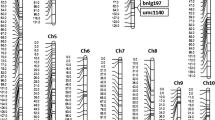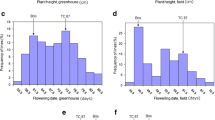Abstract
Random S5 inbreds derived from three F2 maize (Zea mays L.) populations (L1934 × LP918, LP915 × LP2541 and L7310 × L7266) were selected for ear rot resistance after inoculation with a low-fumonisin producing isolate belonging to F. proliferatum. The four less susceptible and the four most susceptible inbreds from each population were crossed and F1 seeds were pooled. Resistant and susceptible pools from each population were evaluated for disease severity (percentage of the ear visibly diseased) after inoculation with the isolate used for selection, and high toxigenic isolates belonging to F. verticillioides and F. graminearum. Grain mycotoxin concentration was assessed by ELISA. Differences in disease resistance to each fungus were observed between resistant and susceptible pools in most populations and environments indicating that selection after inoculation with a single species might be effective to develop broad-based resistance to Fusarium. Resistant pools exhibited, after inoculation with F. verticillioides, low grain fumonisin concentrations in most populations and years. Positive genotypic correlations between disease severity and fumonisin concentration (0.89 < rg < 0.98, depending on fungal species and year) indicate that selection for disease severity accounted for most of the variability for field fumonisin accumulation. Selection seemed to be also effective to reduce grain deoxynivalenol and zearalenone concentrations after inoculation with F. graminearum. Ratios between grain deoxynivalenol concentration and disease severity were lower in L7310 × L7266 than those observed in the other populations suggesting that mechanisms affecting mycotoxin accumulation might exist in this population and additional responses should be feasible if including deoxynivalenol concentration as another selection parameter.
Similar content being viewed by others
References
Cruz CD (2006) Programa Genes: Análise multivariada e simulação. Editora UFV, Viçosa (MG) Brazil, p 175
De León C, Pandey S (1989) Improvement of resistance to ear and stalk rots and agronomic traits in tropical maize gene pools. Crop Sci 29:12–17
Gardiner DM, Kazan K, Manners JM (2009) Novel genes of Fusarium graminearum that negatively regulate deoxynivalenol production and virulence. Mol Plant Microbe Interact 22:1588–1600
Harris LJ, Desjardins AE, Plattner RD, Nicholson P, Butler G, Young JC, Weston G, Proctor RH, Hohn TM (1999) Possible role of trichothecene mycotoxins in virulence of Fusarium graminearum on maize. Plant Dis 83:954–960
Iglesias J, Presello DA, Botta G, Lori GA, Fauguel CM (2010) Aggressiveness of Fusarium section Liseola isolates causing maize ear rot in Argentina. J Plant Pathol 92:205–211
Infostat (2002) Infostat Version 1.1. Grupo Infostat. F.C.A. Universidad Nacional de Córdoba, Argentina
Jardine DJ, Leslie JF (1999) Aggressiveness to mature maize plants of Fusarium strains differing in ability to produce fumonisin. Plant Dis 83:690–693
Leslie JF, Plattner RD, Desjardins AE, Klittich CJR (1992) Fumonisin B1 production by strains from different mating population of Gibberella fujikuroi (Fusarium section Liseola). Phytopathology 82:341–345
Löffler M, Kessel B, Ouzunova M, Miedaner T (2010) Population parameters for resistance to Fusarium graminearum and Fusarium verticillioides ear rot among large sets of early, mid-late and late maturing European maize (Zea mays L.) inbred lines. Theor Appl Genet 120:1053–1062
Miedaner T, Bolduan C, Melchinger AE (2010) Aggressiveness and mycotoxin production of eight isolates each of Fusarium graminearum and Fusarium verticillioides for ear rot on susceptible and resistant early maize inbred lines. Eur J Plant Pathol 127:113–123
Muthomi JW, Oerke EC, Dehne HW, Mutitu EW (2002) Susceptibility of Kenyan wheat varieties to head blight, fungal invasion and deoxynivalenol accumulation inoculated with Fusarium graminearum. J Phytopathol 150:30–36
Perkowski J, Miedamer T, Geiger HH, Müller HM, Chelkowski J (1995) Occurrence of deoxynivalenol (DON), 3-Acetyl-DON, zearalenone, and ergosterol in winter rye inoculated with Fusarium culmorum. Cereal Chem 72:205–209
Presello DA, Reid LM, Butler G, Mather DE (2005) Pedigree selection for Gibberella ear rot resistance in maize populations. Euphytica 143:1–8
Presello DA, Iglesias J, Botta G, Lori GA, Eyherabide GH (2006) Stability of maize resistance to the ear rots caused by Fusarium graminearum and F. verticillioides in Argentinean and Canadian environments. Euphytica 147:403–407
Presello DA, Iglesias J, Botta G, Eyherabide GH (2007) Severity of Fusarium ear rot and concentration of fumonisins in Argentinian maize hybrids. Crop Prot 26:852–855
Presello DA, Botta G, Iglesias J, Eyherabide GH (2008) Effect of disease severity on yield and grain fumonisin concentration of maize hybrids inoculated with Fusarium verticillioides. Crop Prot 27:572–576
Reid LM, Hamilton RI, Mather DE (1996) Screening maize for resistance to gibberella ear rot. In: Tech Bull Publ 1996–5E. Agriculture and Agri-Food Canada, ON
Seitz LM, Mohr HE, Burroughs R, Sauer B (1977) Ergosterol as an indicator of fungal invasion in grains. Cereal Chem 54:1207–1217
Sewald N, Lepschy von Gleissenthall J, Schuster M, Müeller G, Aplin RT (1992) Structure elucidation of a plant metabolite of 4-desoxynivalenol. Tetrahedron Asymmetry 3:953–960
Stewart DW, Reid LM, Nicol RW, Schaafsma AW (2002) A mathematical simulation of growth of Fusarium in maize ears after artificial inoculation. Phytopathology 92:534–541
Acknowledgments
The authors are thankful to the maize breeding and the plant pathology crews at the Experimental Station INTA-Pergamino for assistance with lab and field experiments, To G.A. Lori for providing the isolate belonging to F. graminearum, and to J. Annone, E. Maiola and L. Parisi for reviewing the manuscript. Financial support for this research was provided by the Instituto Nacional de Tecnología Agropecuaria, Argentina (Project PNCER-1332).
Author information
Authors and Affiliations
Corresponding author
Rights and permissions
About this article
Cite this article
Presello, D.A., Pereyra, A.O., Iglesias, J. et al. Responses to selection of S5 inbreds for broad-based resistance to ear rots and grain mycotoxin contamination caused by Fusarium spp. in maize. Euphytica 178, 23–29 (2011). https://doi.org/10.1007/s10681-010-0255-3
Received:
Accepted:
Published:
Issue Date:
DOI: https://doi.org/10.1007/s10681-010-0255-3




